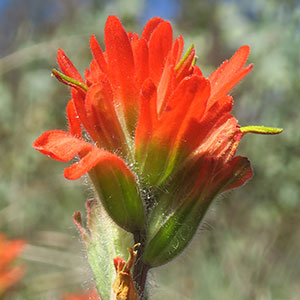Castilleja brevilobata
Castilleja litoralis
short-lobed paintbrush
coast paintbrush, Oregon coast paintbrush, Pacific paintbrush
solitary or few, erect or ascending, unbranched, sometimes branched, hairs spreading, short, medium, and long, soft, short and medium ones short stipitate-glandular.
few to many, usually decumbent proximally, becoming ascending-erect, sometimes ascending, branched, sometimes with small, leafy axillary shoots, glabrate or ± pubescent distally, hairs sparse to moderately dense, spreading to ± appressed, short, soft, sometimes mixed with short-glandular ones below inflorescence.
green or ± yellow, lanceolate, elliptic, or oblong to narrowly ovate, 1–2(–2.5) cm, not fleshy, margins plane or wavy, involute, (0–)3–5(–7)-lobed, apex rounded to acute;
lobes ascending to erect, linear to lanceolate, apex rounded to acute.
green, lanceolate to oblong or narrowly ovate, (0.5–)3–8 cm, sometimes thickened, not fleshy, margins plane, sometimes ± wavy, flat to involute, 0(–3)-lobed, apex acute to rounded;
lobes ascending or spreading, linear, narrowly lanceolate to oblong or triangular, short, apex acute to obtuse.
3–20 × 2–3.5 cm;
bracts proximally greenish to dull brown, distally red, orange-red, or scarlet, sometimes orange or yellow, broadly lanceolate or oblong, (0–)3–5-lobed;
lobes ascending, broadly to narrowly lanceolate, short, arising above mid length, apex acute, obtuse, or rounded.
2.5–21 × 3–5 cm;
bracts proximally green, distally bright red to crimson or orange-red, sometimes orange or pale yellow-orange, oblong to narrowly ovate or narrowly obovate, (0–)3–5-lobed, sometimes with a pair of small teeth;
lobes ascending, linear to oblong, medium length, arising in middle 1/3, central lobe apex obtuse to rounded or truncate, lateral ones ± acute.
0–6 mm.
straight, 15–24(–26) mm;
tube 12–16 mm;
beak exserted, abaxial lip equal to calyx;
beak adaxially green or ± yellow-green, 7–10 mm, puberulent, stipitate-glandular;
abaxial lip deep green, reduced, rounded, 1–2 mm, 10–25% as long as beak;
teeth incurved to erect, light green, 0.5–1 mm.
straight or slightly curved, 23–38(–40) mm;
tube 10–20 mm;
abaxial lip often visible through front cleft, very rarely almost exserted, beak exserted;
beak adaxially green or yellowish, 10–16 mm, surface inconspicuously puberulent;
abaxial lip ascending, green, reduced, 1–2.5 mm, 10–20% as long as beak;
teeth erect or incurved, green or white, 1–2 mm.
green or whitish with green veins, lobes colored as bract lobes or paler, 14–30 mm;
abaxial and adaxial clefts 5.5–8.5 mm, 30–40% of calyx length, deeper than laterals, lateral 1.5–4 mm, 20–25% of calyx length;
lobes oblong to narrowly triangular, apex obtuse to rounded.
colored as bracts, 17–25(–30) mm;
abaxial and adaxial clefts (5–)7–15(–18) mm, 33–55% of calyx length, deeper than laterals, lateral 1–3(–5) mm, 5–10% of calyx length;
lobes broadly triangular to oblong, apex obtuse to acute or rounded.
= 24.
= 120, 144.
Castilleja brevilobata
Castilleja litoralis
Castilleja brevilobata is endemic to dry serpentine openings in the Siskiyou Mountains of southwestern Oregon and adjacent California. Although sometimes treated as part of C. applegatei or C. hispida, its morphology does not suggest a close connection with either. This species occasionally hybridizes with C. pruinosa in Del Norte County, California.
(Discussion copyrighted by Flora of North America; reprinted with permission.)
Castilleja litoralis never ranges more than one to two kilometers from the sea, from Humboldt County, California, north to Pacific County, Washington, near the mouth of the Columbia River. It is a high polyploid complex, possibly incorporating the genomes of several species, including C. affinis, C. miniata, and possibly C. hispida. The coastal C. miniata var. dixonii is very similar ecologically and morphologically but replaces C. litoralis from southwestern Washington to southern British Columbia. Compared to C. litoralis, C. miniata var. dixonii usually has somewhat longer corollas and corolla beaks, the latter with a more conspicuously puberulent surface and deeper lateral calyx clefts. Castilleja litoralis has been included as a subspecies of C. affinis by some (for example, M. Wetherwax et al. 2012), but the morphological resemblance to that species is far more tenuous than it is to C. miniata var. dixonii. Considering their very similar morphologies, along with the fact that both C. litoralis (2n = 120, 144) and C. miniata var. dixonii (2n = 96, 144) apparently combine multiple genomes, strongly suggest that they would best be treated as a single entity. Should they be combined at the species level following additional research, the name C. dixonii has priority.
Castilleja litoralis is often associated with salal, Gaultheria shallon, on which it is likely parasitic.
(Discussion copyrighted by Flora of North America; reprinted with permission.)
- Local floras:
CA,
OR,
WA
- Local Web sites:
CalFlora,
CalPhotos,
Flora NW,
PNW Herbaria
WildflowerSearch
iNaturalist (observations)
USDA Plants Database
- LBJ Wildflower Center
- SEINet
- Plants of the World Online
- Encyclopedia of Life
- Wikipedia
- Google Image Search


